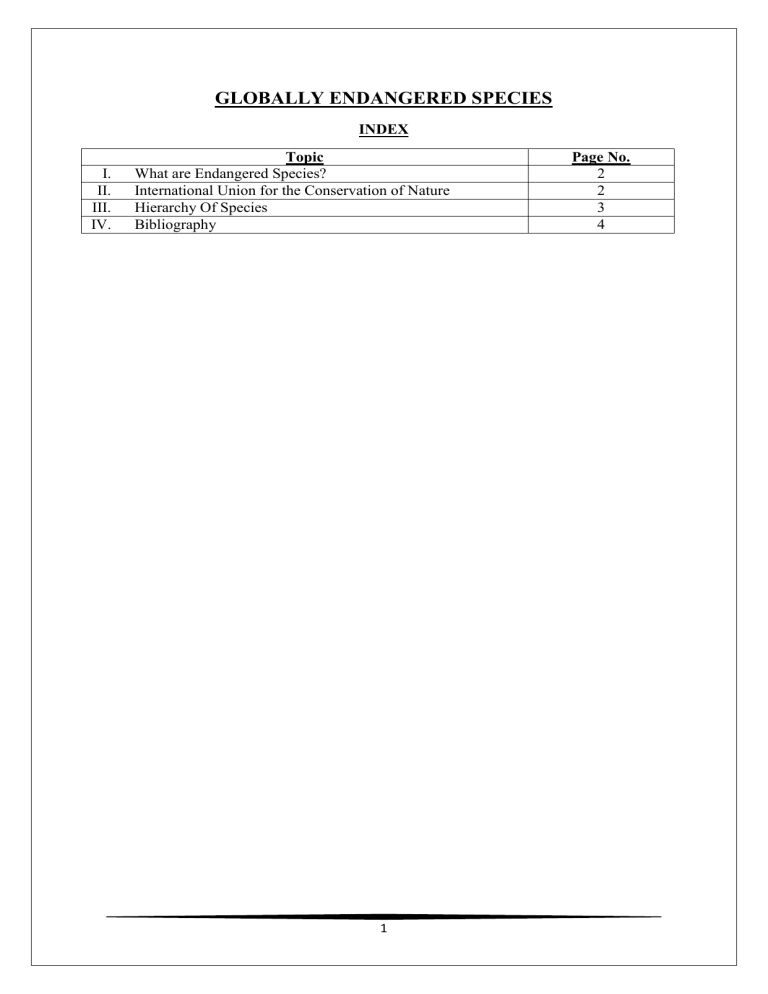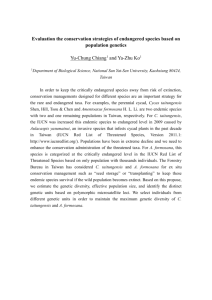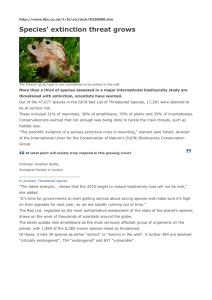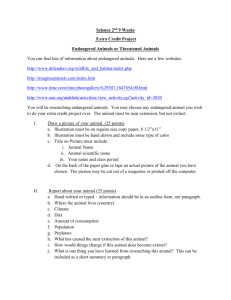
GLOBALLY ENDANGERED SPECIES INDEX I. II. III. IV. Topic What are Endangered Species? International Union for the Conservation of Nature Hierarchy Of Species Bibliography 1 Page No. 2 2 3 4 GLOBALLY ENDANGERED SPECIES I. What are Endangered Species? Endangered Species are a population of animals, plants and other living organisms, that are in danger of becoming extinct. It is used to describe those species whose populations have declined at a rapid rate such that, they could soon disappear from the planet. Endangered species are in immediate danger of extinction and therefore need protection to survive. It is the last stage before any living organism loses its existence forever. Some examples of endangered species are Rhinoceros, Great White Elephants, White Sharks, Polar Bears, African Lions. Endangered species are threatened by several factors, such as hunting, poaching, human encroachment, insufficient breeding rates, habitat destruction, climate changes, that cause their populations to fall at a breakneck speed. Most of them are naturally limited in number and therefore, these factors further accelerate their decline. The current rate of extinction is thought to be far greater than the expected natural rate, with many species going extinct even before they have been discovered. Recent estimates suggest that a third of the world’s amphibians, a quarter of all mammals and one in every eight birds are endangered. Scientists believe that species are becoming extinct at the rate of 1 in every 15 minutes, 100 each day and possibly, 4000-6000 each year. Some studies suggest that as many as one fifth of all the species on earth today will have vanished by the end of the century! Thus, it is imperative so save these gifts of nature and protect them from losing their mark on the planet. II. International Union for the Conservation of Nature (IUCN) The global authority responsible for collecting and gathering data about endangered species is the International Union for Conservation of Nature. They are engaged in classifying species as endangered. IUCN is the world’s largest environmental network created in the year 1948. It has more 1,200 member organisations including governments and NGOs, that work in more than 160 countries around the world. Nearly 11,000 volunteer scientists and experts contribute to its global efforts to safeguard nature. IUCN primarily works in the field of nature conservation and sustainable use of natural resources. It is the main authority responsible for collecting data on the 2 conservation status of species. By combining the latest science with the traditional knowledge of local communities, IUCN’s projects work to reverse habitat loss, restore ecosystems and improve people’s well-being. IUCN helps governments prepare national biodiversity policies. Internationally, IUCN provides advice to environmental conventions such as the Convention on Biological Diversity, CITES and the Framework Convention on Climate Change. It also advises UNESCO on natural world heritage site determination. The most important task performed by IUCN is ascertaining the endangered species. Annually, IUCN releases a list that details all the species of plants and animals which are threatened, endangered and extinct around the world. This is called as the “IUCN Red List of Threatened Species” (also called as IUCN Red List or Red Data List). This the world’s most comprehensive data about the global status of biological species. The Red List is created on criteria such as the Rate of Decline of Population, Population Size, Rate of Geographic Distribution and Degree of Population, which is collected by IUCN from various international organizations. It is the most encyclopaedic data about species and their survival status. The Red List is used by several organisations and governments around the world to protect their natural habitats, form laws and regulations and identify species which are becoming extinct. III. Hierarchy of Species The Hierarchy of Species is an innovative method devised by IUCN in order to track down those species which are becoming extinct. It is used to measure the level of threat to the population of a particular species. A species is categorised in the Hierarchy of Species, depending on its conservation status. The Conservation Status of a species indicates how great the risk is of that species becoming extinct in the near future. Therefore, it categorises species into 9 different levels which are as follows: 1. 2. 3. 4. 5. 6. 7. 8. 9. Extinct (EX) Extinct in the Wild (EW) Critically Endangered (CR) Endangered (EN) Vulnerable (VU) Near Threatened (NT) Least Concern (LC) Data Deficient (DD) Not Evaluated (NE) 3 The most threatened category for a species to be in is Vulnerable, Endangered and Critically Endangered since, at this stage the population of the species is extremely low. If a species reaches this stage, it requires immediate attention and protection from the nature authorities. The cause of its decline should be immediately examined and prevented at the earliest, or else that species may become extinct. The data used to create the Hierarchy is collected from various national and international organizations such as World Wide Fund for Nature (WWF), BirdLife International, Ford Foundation, United Nations Environment Programme and other member organizations. This ensures that all the different species are identified and their conservation status evaluated by IUCN. The Hierarchy is used by several governmental and non-governmental organizations to protect the natural habitats and ecosystems in their surroundings. This is specially used by the Nature Conservation Department of different countries to ascertain the number of species which are threatened and endangered. ----- IV. BIBLIOGRAPHY https://en.wikipedia.org/wiki/International_Union_for_Conservation_of_Nature https://www.iucn.org/about/union/members https://www.iucn.org/ https://en.wikipedia.org/wiki/IUCN_Red_List http://www.iucnredlist.org/ https://www.worldwildlife.org/species/directory https://en.wikipedia.org/wiki/Conservation_status https://www.iucn.org/theme/business-and-biodiversity/resources/business-approaches-andtools/biodiversity-offsets 4




